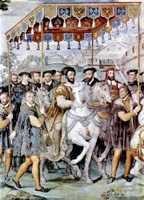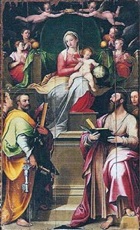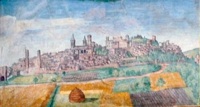
Entrance of Emperor Charles V, King Francis I of France and
Cardinal Alessandro Farnese into Paris in 1540
Fresco (ca. 1560) in Villa Farnese, Caprarola
The brothers Taddeo and Federico Zuccari were born near Urbino.
Taddeo moved to Rome at an early age to train as an artist. He secured the patronage of Pope Julius III and then Pope Paul IV. Federico joined his brother in Rome in ca. 1550, and they worked together until Taddeo’s early death. Their most important achievement was their frescoes for Cardinal Alessandro Farnese in the Sala dei Fasti of Villa Farnese, Caprarola: this work began in 1559 and was still incomplete when Taddeo died in 1566. Federico subsequently brought it to completion.
The first documented independent work by Federico Zuccari was carried out in 1561-63 in Palazzo Vaticano for Pope Pius IV. After Taddeo’s death, Federico established an international reputation. In 1573-74 , he travelled via Lorraine and the Netherlands to England, where he is said to have painted a portrait of Queen Elizabeth I. After his return to Italy, he worked in Florence and Venice. He spent the period in 1585-88 at the court of King Philip II of Spain.
He was elected the first President of the new Accademia di San Luca in 1593, and later gave his house to the academy.
Amelia
Farrattini Altarpiece (ca. 1560)

A document (1696) in the archives of the Farrattini family that identifies the peripheral saints as SS Lucy and John the Evangelist attributes it to Taddeo Zuccari. However, Mariano Guardabassi, who saw the altarpiece in its original position in 1872, attributed it to Taddeo’s younger brother, Federico Zuccari. Modern scholarship, following Giovanna Sapori (referenced below), tends to support this attribution. If this is correct, the panel is among Federico’s earliest independent works.
The altarpiece was designed to complement two funerary monuments in the chapel, one by Ippolito Scalza and another that is attributed to Giovanni Antonio Dosio. Each of these artists was, like Federico Zuccari, just beginning his independent career. The circumstances in which they probably gained these commissions are set out in the page on Cappella Farrattini.
The panel was transferred to Palazzo Farrattini in 1881 and sold in 1913. The Cassa di Risparmio di Terni e Narni bought it in 1990, financed its restoration in 1992, and returned it to its original location.
Narni
Frescoes (1581)
These frescoes in the piano nobile of Palazzo Scotti, which were apparently dated by inscription, are attributed to Federico Zuccari.
Martyrdom of St Margaret of Antioch (1606)
These important frescoes on the walls of Santa Margherita depict four scenes of the martyrdom of St Margaret of Antioch (died 303). They are variously attributed to Federico Zuccari or to Antonio Circignani, il Pomarancio.
Orvieto
Giorgio Vasari records that, “having heard the fame of Taddeo by means of friends, [the Opera del Duomo of Orvieto] sent a summons to him, and he went to Orvieto, taking with him Federigo. There, ... he executed two great figures on the wall of one of [the new chapels in the nave], one representing the Active Life, and the other the Contemplative ...; and while Taddeo was painting those figures, Federigo painted three little stories of St Paul in the recess of the same chapel. At the end of which, both having fallen ill, they went away, promising to return in September”.
Surviving documents record payments made to Taddeo Zuccari in 1559 for work in stucco and fresco in the 5th chapel on the left, together with the commission of an altarpiece for it. However, Tadeo never returned and the altarpiece was never painted.
In 1568, Federico Zuccari accepted a commission for two altarpieces for the new chapels of the Duomo.
-
✴He painted the altarpiece (1569) of Christ raising the son of the widow of Nain (for the 2nd chapel on the left). An early drawing for this altarpiece survives in the British Museum and an engraving by Jacob Matham survives in the Villa Mylius-Vigoni, Menaggio (near Como).
-
✴He renewed the frescoes the 5th chapel on the left (which, as noted above, he had worked on in 1559 as an assistant to his older brother Taddeo), and painted its altarpiece (1570) of Christ curing a blind man. Drawings for this altarpiece survive in the Blanton Museum of Art, Texas and in the Musée du Louvre, Paris, and a sketch for a part of it survives in the Morgan Library and Museum, New York.
The Opera del Duomo accepted the request of Federico Zuccari for extra payment for this work in 1572, by which time it was presumably complete.
The stucco and frescoes were were destroyed in ca. 1890, as described in the page on the 16th century remodelling of the Duomo. The altarpieces by Federico Circignani are now in the Museo dell’ Opera del Duomo, although they were in restoration on my last visit (April 2012).
Perugia
Martyrdom of St Catherine of Alexandria (1582)
This panel in the Collection of the Fondazione Cassa di Risparmio di Perugia, which has been cut down at the sides, is dated by inscription but is of unknown provenance. The arms next to the inscription seem to be those of the Zuccari family, and the work is attributed to Federico Zuccari. It depicts St Catherine standing next to the broken wheel upon which she was supposed to have been martyred. A number of her persecutors have been wounded by the miraculous destruction of the wheel, while others flee in terror.
Spello
Frescoes (16th century)

The Sala degli Zuccari of Palazzo Comunale is named for the frescoes in the frieze around it that are traditionally (but unreliably) attributed to the workshop of Federico Zuccari. They include this view of Spello (1589), which is dated by inscription. (They also include a series of allegorical figures, some of which have recently been attributed to Ascensidonio Spacca, il Fantino).



